Benign Prostatic Hyperplasia (BPH) treatment aims to address the symptoms associated with the enlargement of the prostate gland. One of the primary treatment options for BPH is transurethral resection of the prostate (TURP), a surgical procedure that effectively removes excess tissue and improves urinary flow. Pharmacologic treatments, including alpha-adrenergic blockers and 5-alpha reductase inhibitors, are also commonly employed to manage BPH symptoms.
In addressing the effectiveness of these treatments, research published in the International Journal of Urology emphasizes the complexity of BPH management. Surgical interventions like TURP have been proven effective, providing relief from emptying and retention disorders associated with BPH. Pharmacological approaches, such as alpha-adrenergic blockers and 5-alpha reductase inhibitors, play a crucial role in symptom relief.
Additionally, lifestyle modifications and smooth muscle relaxant alpha-blocker therapy are initial management strategies for BPH. These alpha-blockers often demonstrate a quick onset of action, contributing to their efficacy in addressing lower urinary tract symptoms associated with BPH.
What is benign prostatic hyperplasia?
Benign prostatic hyperplasia (BPH) is an age-related health issue, also known as an enlarged prostate, affecting the prostate gland located just below the bladder.
BPH, characterized by prostate enlargement, commonly occurs in men over 50. The prostate’s growth can lead to symptoms such as frequent urination, weak urine stream, and nighttime urgency. The exact cause is unclear, but hormonal changes and age-related factors contribute. Treatment options vary, including lifestyle changes, medications, minimally invasive procedures, and surgery, depending on symptom severity. While BPH doesn’t raise prostate cancer risk, complications like urinary retention can occur. Awareness of symptoms and appropriate medical consultation are crucial for effective management.
What causes benign prostatic hyperplasia?
Benign prostatic hyperplasia (BPH), marked by the enlargement of the prostate gland, commonly affects men as they age. The gland’s growth, not cancerous, occurs around the urethra and is associated with factors like aging, altered testicular cell composition, and testosterone levels. The prevalence of BPH increases with age, ranging from 8% to 60% by age 90. The exact cause of prostate enlargement remains unknown, with hormonal changes, especially from the testes, considered a primary factor.
Lifestyle elements like obesity and physical inactivity may influence BPH symptoms. Understanding the epidemiology of clinical BPH is crucial, as prevalence rises with age, and inflammatory markers may play a role in lower urinary tract symptoms. Although the exact cause remains unclear, a comprehensive strategy for prevention and control involves addressing age-related factors and hormonal changes associated with BPH development.
If you have any BPH Benign prostatic hyperplasia symptoms then you can consult with Dr.Samarth Agarwal, top Urologist in Siliguri.

Treatment Options for BPH
Medicines for an enlarged prostate
The medical treatment for BPH involves a range of medications. Alpha-Blockers, such as tamsulosin and doxazosin, relax the smooth muscle of the bladder and prostate, making urination easier. 5-Alpha Reductase Inhibitors, like finasteride and dutasteride, shrink the prostate by preventing hormone-induced growth. Tadalafil (Cialis), known for erectile dysfunction, is also used for an enlarged prostate. Additionally, a combination of medications might be prescribed for optimal results. It’s crucial to consult with a healthcare professional to determine the most suitable medicine based on individual symptoms and health conditions.
Surgery and other treatments for an enlarged prostate
Surgical treatments for an enlarged prostate, such as Transurethral Resection of the Prostate (TURP), involve procedures like laser therapies, open prostatectomy, and minimally invasive techniques. TURP, a common surgery, utilizes a resectoscope to trim excess prostate tissue, providing relief from urinary symptoms. Alternative procedures like Holmium laser and prostatic urethral lift (PUL) implants offer viable options.
While complications may include bleeding or erectile dysfunction, the choice of surgery depends on factors like prostate size and individual health. Consultation with a doctor is crucial to assess risks and benefits tailored to each patient’s needs.
Transurethral resection of the prostate (TURP)
Transurethral resection of the prostate (TURP) is a common surgical procedure that involves removing part of the prostate gland to alleviate symptoms of an enlarged prostate.
TURP, a widely used procedure for benign prostate disease, entails the surgical removal of the middle part of the prostate through the urethra. This alleviates symptoms like difficulty urinating caused by an enlarged prostate. Alternative surgical methods, including open enucleative prostatectomy, laser TURP, transurethral incision of the prostate (TUIP), and UroLift®, offer choices based on individual cases. TURP’s effectiveness is notable for moderate to severe urinary issues, though potential risks like urinary tract infections and low sodium levels exist.
Newer techniques, such as the PLASMA system and holmium laser enucleation of the prostate (HoLEP), aim to provide comparable effectiveness with fewer side effects and shorter recovery times. Notably, prostate artery embolization (PAE) is emerging as a minimally invasive alternative, particularly for patients unsuitable for TURP due to factors like anesthesia intolerance or larger prostates. Understanding the risks and benefits, as well as considering individual health conditions, aids in determining the most suitable approach to address an enlarged prostate and associated urinary symptoms.
Transurethral incision of the prostate (TUIP)
Transurethral incision of the prostate (TUIP) is a minimally invasive procedure for treating urinary symptoms associated with an enlarged prostate, also known as benign prostatic hyperplasia (BPH).
TUIP involves using a resectoscope inserted through the penis to make one or two small cuts in the prostate, relieving symptoms like urgency, slow urination, and nighttime frequency. Typically preferred for smaller prostates in younger men concerned about fertility, TUIP offers advantages such as lower bleeding risk and minimal hospital stay.
While effective, potential complications include urinary tract infections and the need for re-treatment, and noticeable improvement may take several weeks. Consideration of alternatives and consultation with a healthcare professional is crucial in determining the most suitable treatment for BPH, tailored to individual circumstances and health conditions.
Transurethral microwave thermotherapy (TUMT)
Transurethral microwave thermotherapy (TUMT) is an outpatient procedure addressing urinary symptoms from an enlarged prostate (benign prostatic hyperplasia or BPH), involving a microwave antenna inserted through the penis to destroy excess prostate tissue, improving urine flow.
TUMT is considered safe with minimal risks, offering advantages such as lower bleeding risk and no hospital stay. It may take weeks to months for noticeable improvement, and potential complications include urinary symptoms and infections. TUMT’s efficacy and safety are supported by studies, with considerations for patient eligibility based on health conditions and medication use. Despite being generally well-tolerated, re-treatment might be necessary for some individuals.
According to the study conducted by Daniel S Kellner et al. in 2004, titled “Efficacy of high-energy transurethral microwave thermotherapy in alleviating medically refractory urinary retention due to benign prostatic hyperplasia,” the researchers aimed to determine the effectiveness of high-energy transurethral microwave thermotherapy (HE-TUMT) in treating patients experiencing medically refractory complete urinary retention secondary to benign prostatic hyperplasia (BPH).
Between April 2000 and July 2003, 39 patients in urinary retention due to BPH underwent treatment with HE-TUMT. After the procedure, a Foley catheter was reinserted and removed at 3 weeks for a voiding trial. Patients unable to void were recatheterized, and voiding trials were repeated at 2-week intervals. Evaluation criteria included history and physical examination, prostate-specific antigen level, prostate volume, cystourethroscopy, International Prostate Symptom Score, quality of life score, peak uroflow, and postvoid residual.
The study reported that 32 out of 39 patients were able to void successfully after HE-TUMT, resulting in an overall success rate of 82%. Patients who achieved successful voiding after HE-TUMT had a mean of 1.6 voiding trials and required catheters for a mean period of 4.1 weeks. However, only 15% of the patients who were voiding successfully were able to discontinue their medication for BPH.
Laser therapy
Prostate laser surgery, including techniques like photoselective vaporization and holmium laser enucleation, effectively alleviates moderate to severe urinary symptoms caused by an enlarged prostate, known as benign prostatic hyperplasia (BPH).
Prostate laser surgery employs various methods, such as photoselective vaporization (PVP), holmium laser ablation (HoLAP), and holmium laser enucleation (HoLEP), to address BPH symptoms by removing excess prostate tissue.
The choice of laser surgery depends on factors like prostate size, patient health, and the availability of laser equipment. While these procedures generally lead to improved urinary flow, potential side effects include temporary difficulty urinating, urinary tract infection, bleeding, retrograde ejaculation, and, rarely, the need for retreatment. It’s crucial to discuss benefits and risks with your doctor before choosing a laser therapy approach.
Prostate lift
Prostatic urethral lift (PUL) is a minimally invasive procedure for managing benign prostatic hyperplasia (BPH) by lifting and compressing the enlarged prostate, providing relief from lower urinary tract symptoms (LUTS).
Prostatic urethral lift (PUL) is a promising minimally invasive procedure for managing BPH-associated LUTS. This procedure involves the placement of tiny implants in the prostate, lifting and compressing the enlarged tissue. PUL can be performed under various types of anesthesia and has shown improvements in LUTS while preserving erectile and ejaculatory function.
According to the study conducted by Jae Hung Jung, Balaji Reddy, Karen Ann McCutcheon, Michael Borofsky, Vikram Narayan, Myung Ha Kim, and Philipp Dahm, titled “Prostatic Urethral Lift for the Treatment of Lower Urinary Tract Symptoms in Men with Benign Prostatic Hyperplasia,” published in 2019, the prostatic urethral lift (PUL) offers a minimally invasive surgical approach for managing lower urinary tract symptoms (LUTS) in men with benign prostatic hyperplasia (BPH)1. This study aims to assess the effects of PUL in treating LUTS associated with BPH.
Combination therapies and novel procedures like PUL, with their associated benefits and potential side effects, contribute to the comprehensive approach to address prostate growth and large prostate symptoms.
Water vapor thermal therapy (WVTT)
Water vapor thermal therapy (WVTT) is a minimally invasive surgical procedure used to treat benign prostatic hyperplasia (BPH). Here are the key points about WVTT from the provided text:
- It involves using a few drops of heated water to treat the excess prostate tissue causing BPH symptoms.
- It is performed under sedation or local anesthesia, without the need for general anesthesia.
- Patients consider several attributes when choosing WVTT, including:
- Treatment durability (avoiding need for retreatment)
- Cost of the procedure
- Preserving sexual function
- Avoiding daily BPH medications
- Avoiding more invasive surgeries like transurethral resection of the prostate (TURP)
- Avoiding long wait times for other surgical BPH treatments
- Quick recovery and return to normal activities
Robotic waterjet treatment
Robotic waterjet treatment, Aquablation therapy, utilizes a heat-free waterjet with robotic precision for long-lasting relief from benign prostatic hyperplasia (BPH).
Aquablation therapy is an advanced, minimally invasive procedure for BPH. Using a heat-free waterjet controlled by robotic technology, it precisely removes prostate tissue, offering relief without compromising sexual function. The procedure, performed through the urethra, treats the entire prostate regardless of size. It uniquely combines a cystoscope and ultrasound imaging for real-time visualization. Aquablation therapy boasts low rates of irreversible complications and has demonstrated safety and effectiveness in treating symptomatic BPH, maintaining sexual preservation. The efficacy is supported by trials, indicating its potential as a benchmark in robotic waterjet ablation therapy for refractory BPH.
Open or robot-assisted prostatectomy
Robotic-assisted simple prostatectomy is a preferred option for benign prostatic hyperplasia (BPH), offering advantages such as smaller incisions, reduced blood loss, and faster recovery compared to open surgery.
Robotic techniques, like the da Vinci Surgical System, enable precise removal of the enlarged prostate, resulting in smaller incisions, less blood loss, reduced pain, a shorter hospital stay (usually one to two days), and faster overall recovery. Temple Health has pioneered an improved robotic simple prostatectomy technique, becoming the highest-volume center in the US since 2014. Research supports the feasibility and effectiveness of robotic-assisted procedures for large prostates, providing similar functional outcomes to open approaches with advantages like reduced length of stay and blood loss.
Embolization
Prostatic artery embolization (PAE) is an effective and safe treatment for symptomatic benign prostatic hyperplasia (BPH). PAE, performed by interventional radiologists, offers a lower risk of urinary incontinence and sexual side effects compared to more invasive surgical procedures like transurethral resection of the prostate (TURP). Typically suitable for those ineligible or uninterested in traditional surgery, PAE involves blocking prostatic arteries, leading to prostate shrinkage and symptom relief.
With over 95% of men experiencing symptomatic improvement, it’s considered a valuable option. Patient evaluation, understanding pelvic arterial anatomy, and meticulous embolization are crucial for optimal results. Possible risks include post-PAE syndrome, hematoma, and infection, emphasizing the importance of skilled practitioners. Emerging studies and meta-analyses support PAE’s efficacy, positioning it as a promising choice for managing BPH symptoms.
What is the safest treatment for BPH?
Laser therapy is a safe option for treating BPH, offering a lower risk of side effects than non-laser surgery. It becomes particularly suitable for individuals who can’t undergo other prostate procedures due to blood-thinning medications. The high-energy laser effectively destroys or removes overgrown prostate tissue, providing a minimally invasive alternative with reduced risks.
What is the first choice in treatment for BPH?
Alpha blockers stand as the primary choice for treating lower urinary tract symptoms (LUTS) caused by BPH. These drugs, including tamsulosin and alfuzosin, exhibit efficacy and safety proven through numerous randomized trials. Alpha blockers begin to work swiftly and are typically recommended as a first-line treatment, especially for men with mild to moderate symptoms. Their effectiveness makes them a key intervention to alleviate the symptoms associated with an enlarged prostate.



